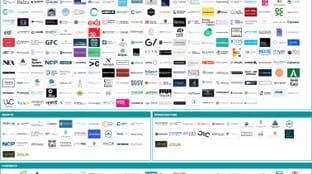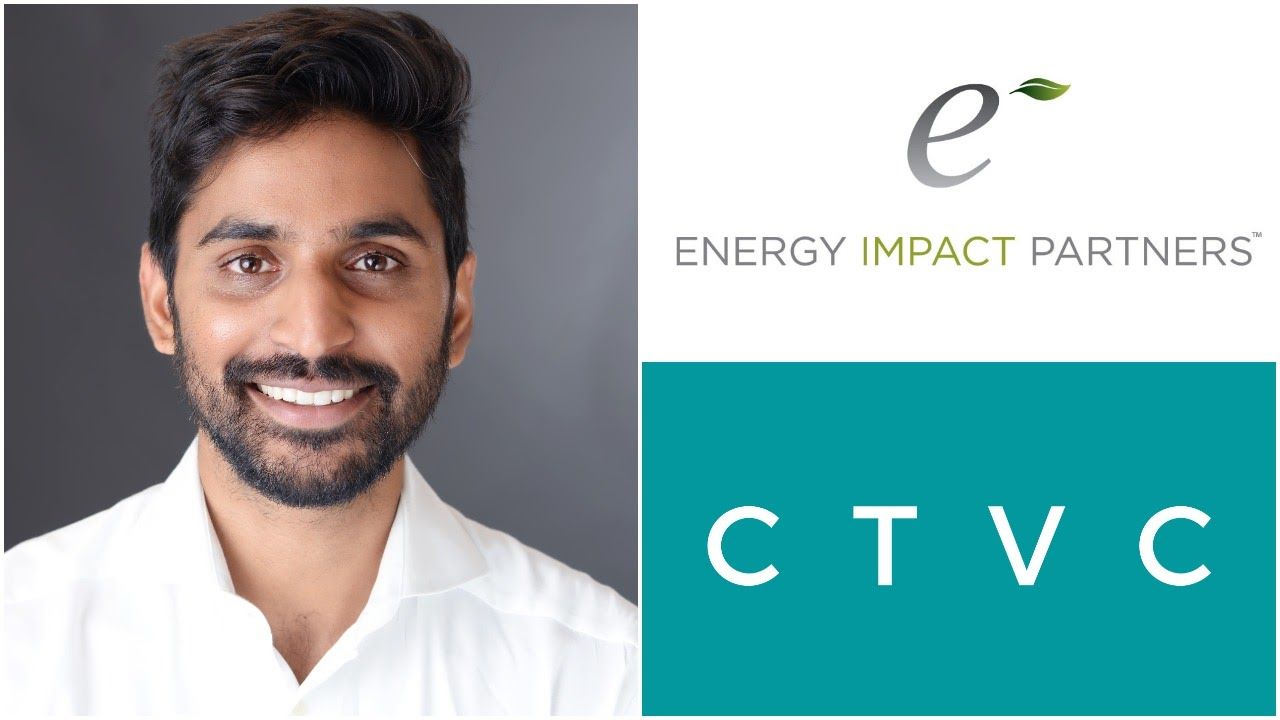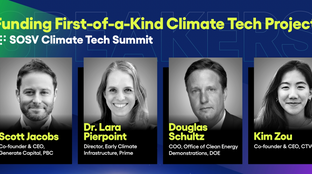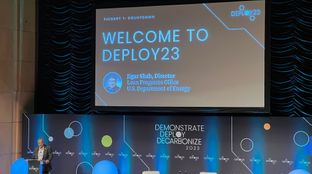
🌏 Who are the Climate Tech Investors?
A new interactive Climate Capital Stack Map
EIP raises $1B to collectively drive decarbonization

Founded by the team pioneering GE’s strategic investing model, Energy Impact Partners has built an energy & industrial coalition with reach across the often distant worlds of utilities and climate tech startups. After a successful first fund five years in the making, EIP just announced a $1B “gigafund” backed by strategics across the utility, energy, real-estate, mobility, and industrial sectors to invest in a net zero economy. EIP Partner Sameer Reddy pulls back the curtain on the conversations keeping incumbents up at night, opportunities for a giga-sized strategic fund, and the frontier edge of decarbonization.
[Disclaimer: Kim is an investor at Energy Impact Partners.]
Energy Impact Partners has been investing in climate tech for 6 years now. What’s the founding story behind EIP and how you came to be a part of it?
The EIP story was decades in the making and was really founded by Hans Kobler, our CEO. He ideated on the concept of EIP while at GE having pioneered their strategic investment model. In the early 2000s, GE provided an incredible network of experts and scientists in aviation, energy, water, industrial tech, cybersecurity and more. When we invested in the wind blade company TPI at GE, we were able to talk to world class scientists like Jim Lyons who headed up their research organization.
Meanwhile, during Cleantech 1.0, we saw that a big challenge and missed opportunity was not including the incumbents at the table to really help accelerate sales cycles. So a big part of EIP’s model is a recognition that in order to really scale innovation in this space, you need to bring more than just money. You need to be able to connect the start-up ecosystem with the players in the ecosystem that really have scale.
When I joined EIP, we were basically a startup ourselves looking for our own form of product market fit - we were four people working out of a basement and my first day largely consisted of shopping for a computer at Best Buy. Today, our 4-person team is now 70+ of the smartest people I’ve ever worked with across 5 offices around the globe. We have an incredible network of strategic LPs that range from 10 of the largest utilities in North America to Microsoft to major fleet operators like Enterprise to real estate companies. Our focus today goes back to our origin story - creating that self-fulfilling prophecy where we drive value to our portfolio companies by tapping into that network of expert LPs.
What’s the difference between EIP’s model compared to traditional corporate venture (CVCs) or generalist venture firms?
We pulled inspiration from both investing approaches and recognized there was no perfect template for our model so we had to create it. There are things that CVCs do exceptionally well. Their access to experts within their own internal business units is an incredible resource. Early on, we knew that had to be a core competency at EIP and it’s an area we’ve invested in heavily. It’s one thing to just have big strategic names invested in a fund, but we wanted to create deep and lasting relationships with every single LP and every single one of their business units. It takes years of dedicated effort to develop those relationships and our own in-house research and innovation team grew from this challenge to help build and facilitate those relationships.
When I look at generalist firms, especially in this market, the ability to stay agile and evolve your investing strategy with current market dynamics is almost existential. We prioritize many facets commonly associated with a generalist firm - we’re incredibly active from a board perspective, we prioritize speed and agility, and we almost always lead. The only slight twist is that most folks on our investment team have spent their entire careers in the broader climate tech space in various capacities and therefore bring a ton of domain expertise to the table.
What are examples of how this strategic model has been successful for EIP’s investments?
One example is a company called Urbint which leverages artificial intelligence to predict infrastructure risk, largely caused by climate change. When we invested in Urbint, PG&E was going through all kinds of unprecedented challenges around wildfires. For the first time, we were seeing shareholder value meaningfully impacted by events specific to climate. Similar to what we saw in cybersecurity 10 years ago, we had a front row seat through our LPs to better understand how climate-related disasters were being elevated to the C-Suite level which was also creating meaningful budget. While that might seem obvious in hindsight, at the time it allowed us to get to conviction quickly and lean into Urbint’s Series A raise.
On a more tactical level, post-investment, we’re able to get startups like Urbint in front of the heads of every single business unit within a utility and all their subject matter experts. In addition to driving revenue to our portfolio companies, we deliver product insights that can help early-stage companies better navigate product market fit. If you talk to Corey, the founder and CEO of Urbint, he’d probably say our real value-add came from helping to define their product roadmap by better understanding the voice of the customer.
What are some other climate topics keeping C-Suite leaders up at night?
If I were to boil it down, it’s really solving the equation between electrification of demand, decarbonization of supply, and reliability. Many of our LPs have made various forms of Net Zero pledges, and are navigating how to get there practically. These are incredibly sharp folks who have spent the last two decades tackling the low-hanging fruit that maybe gets you a path to 50-60% of the way to Net Zero, and are now thinking through how to solve harder problems like: how to decarbonize natural gas infrastructure, how do you manage the reliability of the grid during through an exponential increases in electrification, how do you electrify industrial and residential heating, or what solutions exist to decarbonize baseload power?
Those critical questions are why companies like Form Energy resonate so well with many of our LPs. At some point, renewables and traditional lithium ion storage will only get you so far. We’re going to need new forms of clean baseload generation and multi-day seasonal storage. Another part of the answer is demand flexibility behind the meter. I’m convinced that we will need as much flexibility as possible across pretty much every major market in the US. Companies like Enchanted Rock and Arcadia are playing an incredibly important role on that front.
Green Hydrogen and Synthetic Natural Gas are also gaining a lot of steam, as part of the broader theme of decarbonizing natural gas while leveraging the trillions of dollars of underground infrastructure that exists today. Understanding the specific use cases that will prevail remains an open question but we think there are some companies like Electric Hydrogen that are taking a really differentiated approach to producing green hydrogen at scale.
What areas of the energy transition did you focus on in the first fund? Where do you see the next growth areas in this new fund?
Our macro focus remains the same on transportation and smart cities to decarbonization of the grid and distributed generation. From a micro perspective, we’re leaning in harder on particular subsegments. For example, Urbint was just the tip of the iceberg for us in climate infrastructure risk. That's a huge category of enterprise software that's going to emerge over the next couple of decades. We're still in the infancy of many of the pain points that infrastructure operators, not just utilities, are facing around climate change. A lot of that's not really priced into markets.
Resiliency will be critical in the energy transition. The price of resiliency is going to the moon and we can’t get enough of it. Utilities are in the unfortunate place of being blamed when something goes wrong, but they don't get credit for managing all of the complexity required to keep the lights on. Part of the challenge for them is how to decarbonize their operations - retire natural gas and coal, electrify heating and transportation all while maintaining the reliability of the grid. Resiliency can come in the form of microgrids, more efficient transmission, battery storage, or even more resilient homes and buildings. There are a lot of different ways to play that theme.
Growth in EV adoption is going to present a huge opportunity and set of challenges for utilities. They plan on multi-year cycles, but are in the middle of some really exponential trends in electricity usage within their service territories. If their forecasts are off by 10 or 20% on EV adoption, it could entirely change the way they plan for the grid. We need solutions that can help better integrate the real time impact of EVs and other distributed energy resources. We're still in the infancy of DER adoption and we're going to see next gen solutions that incorporate DERs to help utilities plan more dynamically. We're invested in a company called Opus One, which is a great example of transitioning utility behavior from static planning to real-time. The future picks and shovel approaches around EVs will make for some really exciting companies.
What’s the frontier edge of the utility x climate intersection?
I’d love to see “transactive energy” finally come to fruition - though it probably needs a name rebrand at this point. We need software intelligence and monetization market models for the solutions and resources that exist behind the meter. This would effectively look like a marketplace whereby utilities can dynamically call on energy resources behind the meter, that exist within homes or within commercial and industrial buildings, and dynamically compensate them for participation. It’s one of those obvious win-wins for customers, utilities, and climate.
But in order for that to happen, a ton of other things have to be true. Think about the cybersecurity implications of a utility relying on dispatch from a network of smart water heaters created by one OEM, which I can assure you hasn't thought about product security. Think about the market models that have to exist in order to compensate those resources fairly.
Green hydrogen has created a bit of a self fulfilling prophecy for itself with the buzz both in public markets and policy worlds. Understanding the specific use cases of green hydrogen and how cheaply we can produce it at scale remains an open question. Given some of the constraints we’re seeing around transmission infrastructure buildout, I’d also love to see more innovation around distribution interconnected baseload resources like linear generators or small modular nuclear reactors.
What do others get wrong about investing in this space?
I want to approach this question with a bit of humility. There are a ton of smart new investors moving into the space and also many that have been around the table for a long time with battle scars from the past. As more generalists invest in climate, there’s an innate bias towards the traditional venture model of investing in capital light, enterprise software businesses. While I definitely think we’ll see our fair share of multi-billion dollar climate software outcomes, like Arcadia, some of the biggest outcomes over the next decade will be messy, complex, and capital intensive businesses.
Many of the top climate tech companies by market cap, like Enphase, SolarEdge, and Bloom Energy, are all incredibly hardware intensive companies that have taken multi-decade, non-linear paths to get to this point. Investors need to embrace this complexity and have patience, because the innovation and adoption cycles in our space are just fundamentally slower.
We recently wrote about the Climate Capital Stack. How do you define the capital stack for climate and how does EIP fit into that landscape?
Within the capital stack you laid out, EIP plays in everything from early catalytic capital to later-stage venture and commercial debt. We don't yet play on the bookends of grants or infrastructure. When I think about EIP’s model, we’re investing heavily in the platform. We’ve built teams around research & innovation, ESG, and back office infrastructure. We see ourselves as a platform that can launch new products to meet whatever the market is looking for. Within the traditional equity context, we want to be able to be the first check into a company (Seed or Series A), the last check (pre-IPO or growth round), and operate everywhere in between. Great founders and companies operate at every stage of the spectrum you laid out, so we really need to stay flexible. Our goal today is to cover 80% of the Climate Capital Stack - and in five years from now - perhaps cover the entire gamut.
Where do you see the gaps in funding climate innovation?
There's been a lot of excitement around new infrastructure capital flowing into the market, but a lot of that capital still struggles to embrace early stage tech complexity. Generate Capital has done a fantastic job pioneering this type of infra financing. Even for companies like Form Energy, which are first-of-its-kind and creating a step-change in technology, there’s still a significant gap on the infrastructure capital side.
The other key driver accelerating climate tech is talent. What’s different about the type or scale of talent entering climate tech today?
This is one of the most exciting parts about this whole transition and what really makes today feel different from the last cleantech wave. There’s never been a more compelling time to bet your career on climate tech - the policy, investment, and startup ecosystem are all aligning in a way that’s really exciting. I had a conversation with Daversa, which is one of the top exec search firms in the world, who said that 7 out of 10 of the candidates they interview want to be considered for a career in sustainability. We’re seeing this firsthand in our portfolio. Arcadia has been able to recruit from the likes of Pinterest and ClassPass. Urbint has recruited from Palantir, Salesforce and Datadog. Some of the best talent in the world is moving into this space not just because they want to prioritize impact, but because they see this as a path to make an incredible financial return. I think both of those things have to coincide to really transition talent from traditional big tech into climate tech.
Congrats, EIP just raised $1B for Fund II! How do the LPs and strategy differ this time around?
From a macro perspective, everything has changed. The public markets have really woken up to the opportunity that climate tech companies present. The investment landscape has also expanded. Six years ago, we were a $500m fund and we would get questions as to whether there were enough investable companies for a fund of that size. Now we’re twice the size and see endless opportunities across the spectrum.
In terms of EIP’s specific strategy, we’re doing more of the same with a broader universe of strategic LPs. As we think about what we've really institutionalized at EIP, it's the ability to connect strategic LPs with innovative startups in a virtuous cycle that creates value for all parties involved. Utilities continue to be the lifeblood of our strategic coalition, but we’ve now expanded our strategic partner base into real estate, transportation, and industrial operators. Broadening out that coalition is really exciting because it increases the number of tools that we have to deliver value to our portfolio companies. The next wave of decarbonization and electrification will not only affect utilities, but industrial, transportation companies and real estate operators - basically anyone with a significant load. And those intersections will only become more obvious with time.

A new interactive Climate Capital Stack Map

Financing around first- or early-of-a-kind project risk

‘Government-enabled, private sector-led’ in action in Washington, DC